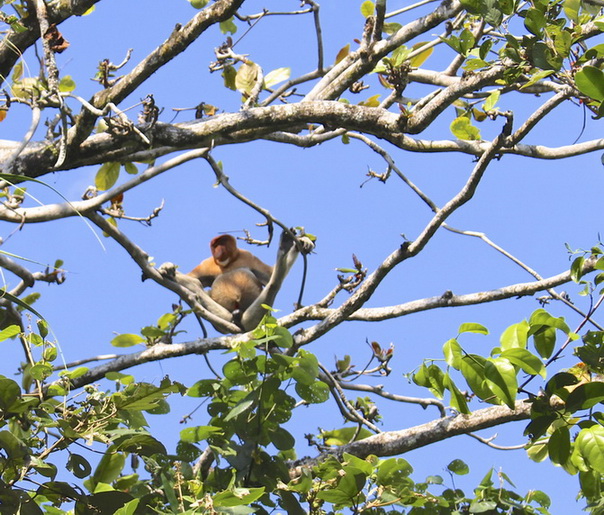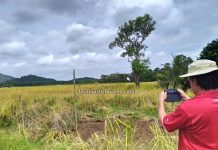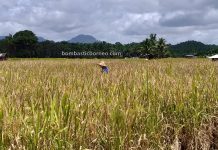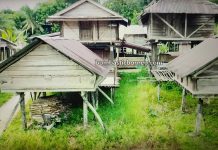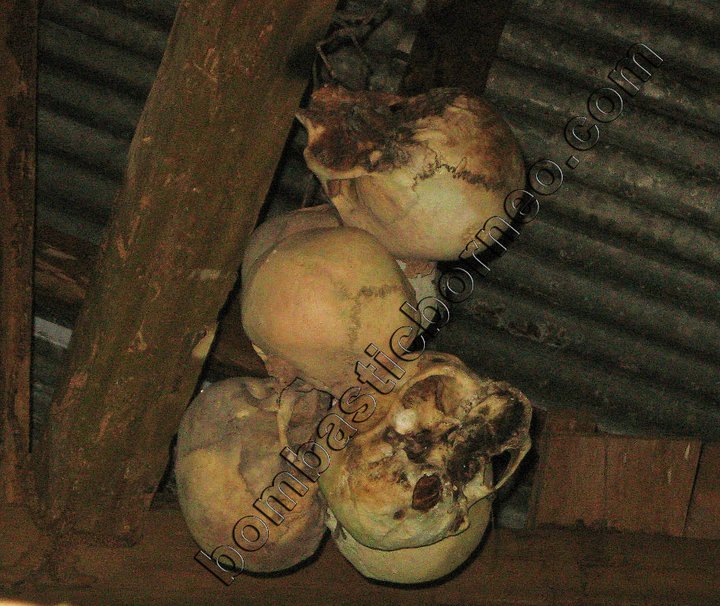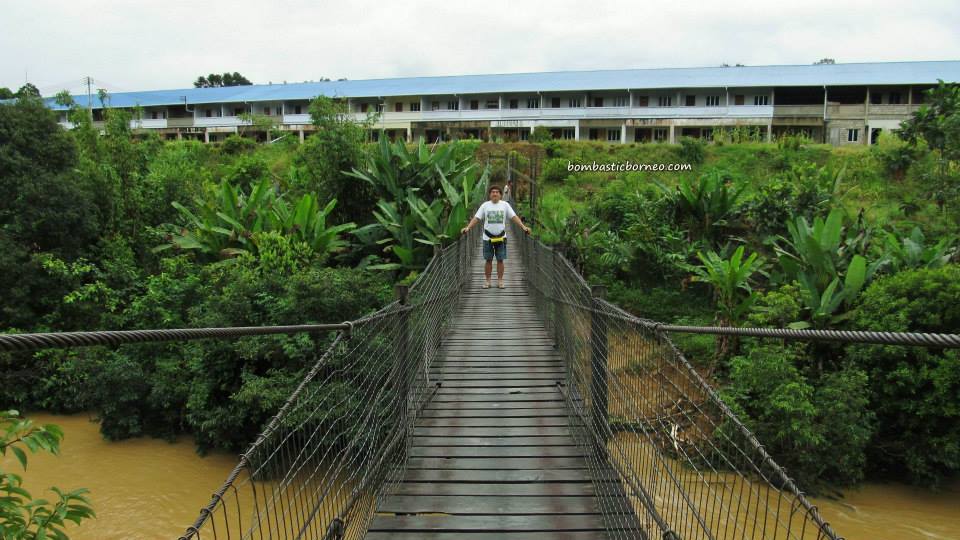Location : Bako National Park, Kuching, Kuching Division, Sarawak, Malaysia.
Gazetted in 1957, Bako is Sarawak’s oldest national park, covering an area of 2,727 hectares at the tip of the Muara Tebas peninsula. It is one of the smallest national parks in Sarawak, yet one of the most interesting, as it contains almost every type of vegetation found in Borneo.
Guest written by Lindsay Schenk.
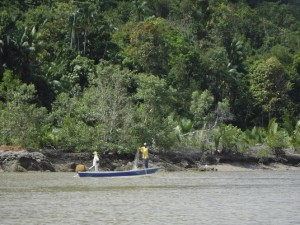 As the visitor cruises in a small boat down the Sungai Bako (Bako River) towards the South China Sea, dense jungle lines the shores interrupted by the occasional dilapidated house or shack. Small boats putter along while fisherman cast their nets. As the sea draws near, the river widens and the vegetation grows even lusher. Eventually the boat veers right into a wide bay with opaque brown water and a wide sandy beach (especially at low tide), lined with tall trees masking the interior and bookended by two small mountains. The boat stops in knee deep water and the Bako visitor clambers out of the boat with luggage held high, wading to shore and walking up the beach toward the wall of vegetation masking Park Headquarters. Exotic Bako National park can only be reached by boat and sits where the Sungai Bako meets the South China Sea.
As the visitor cruises in a small boat down the Sungai Bako (Bako River) towards the South China Sea, dense jungle lines the shores interrupted by the occasional dilapidated house or shack. Small boats putter along while fisherman cast their nets. As the sea draws near, the river widens and the vegetation grows even lusher. Eventually the boat veers right into a wide bay with opaque brown water and a wide sandy beach (especially at low tide), lined with tall trees masking the interior and bookended by two small mountains. The boat stops in knee deep water and the Bako visitor clambers out of the boat with luggage held high, wading to shore and walking up the beach toward the wall of vegetation masking Park Headquarters. Exotic Bako National park can only be reached by boat and sits where the Sungai Bako meets the South China Sea. 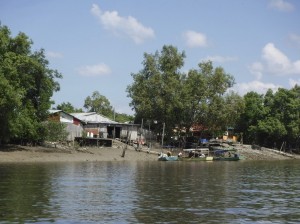
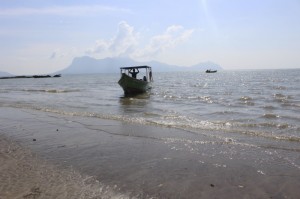
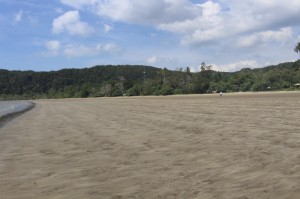
Some people only visit Bako on a day trip for a short hike, others stay overnight and some stay for more than one night. It is (i) absurdly hot and humid (Tennessee in August feels like a desert relative to this humidity) and (ii) there is no accommodation with air conditioning so it is usually several degrees warmer inside than outside, causing the rooms to have a permanent musty/moldy smell. Nonetheless, the stunning hiking and proboscis monkeys warranted two nights for me.
Bako’s Wildlife
Bako is famous for the endangered Proboscis monkey, found only on Borneo. Spotting a proboscis monkey in Bako is apparently a rare treat, although I saw four. They look quite different from the visual image that comes to mind when one hears the word “monkey.” In fact, a sighting leads inevitably to (slightly immature) laughter, and not because of the sitting position of the proboscis monkey in the picture below. They have pendulous (as the park brochure puts it) noses and comical potbellies. 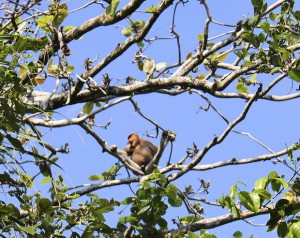 Each time that I saw a proboscis, it was tearing apart branches and stuffing its mouth, taking an occasional short break to rest.
Each time that I saw a proboscis, it was tearing apart branches and stuffing its mouth, taking an occasional short break to rest.
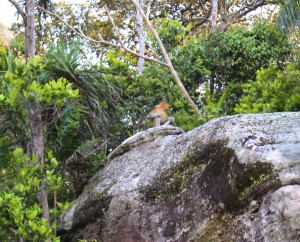
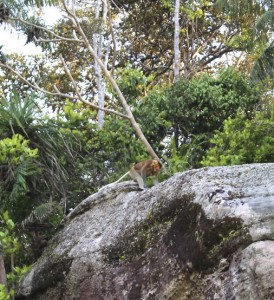 The park rangers offered night walks in the jungle every night from 8 – 9:30 pm. We saw snakes, spiders, frogs, and birds asleep in nests. This cute snake also hung out near headquarters during the day.
The park rangers offered night walks in the jungle every night from 8 – 9:30 pm. We saw snakes, spiders, frogs, and birds asleep in nests. This cute snake also hung out near headquarters during the day. 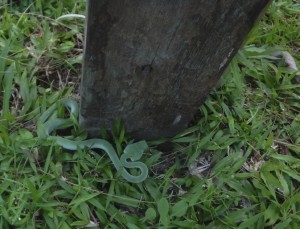 The signs around the Bako headquarters are entertaining, if not particularly helpful.
The signs around the Bako headquarters are entertaining, if not particularly helpful. 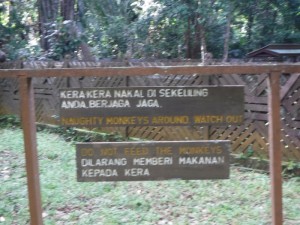
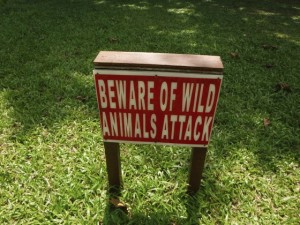
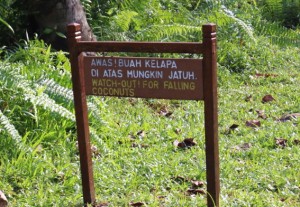 The signs warning (for example, the far left picture above) “naughty monkeys” – referring to macaques, not proboscis – are a gross understatement. Evil, demonic monkeys would be more accurate.
The signs warning (for example, the far left picture above) “naughty monkeys” – referring to macaques, not proboscis – are a gross understatement. Evil, demonic monkeys would be more accurate.
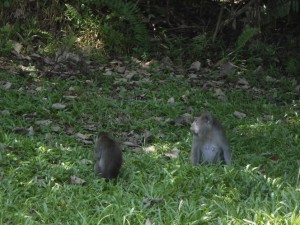
At the very least, “aggressive” might instill the proper amount of fear as opposed to the cute phrase “naughty monkeys.” The first morning as I exited the dorm room, three macaques waited on the porch. Two of them approached to within a few feet, hissed and made threatening lunges towards me, arms making grabbing motions. Although small, the look in one macaque’s intelligent hazel eyes as we stared at each other during our standoff is the stuff of nightmares. I fled to the kitchen/bathroom area adjoining the dorm and slammed the door shut. My Spanish roommate, a big guy, happened to be in the kitchen area and he managed to scare the monkeys away. I saw monkeys jump onto two different tables at the canteen and steal food – both times surprising a scream out of the person sitting at the table. Overnight the macaques overturned the trash cans in front of the public restrooms and tore apart two soda cans, both of which right side up at the bathroom entrance.
A more humorous animal also hangs around headquarters with the staff and people – Borneo Bearded Wild Pigs. They actually have beards. Despite their large size, in contrast to the nasty macaques, these pigs are scared of people and startle when a person approaches to take a photograph. 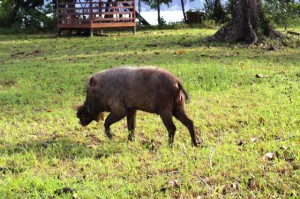
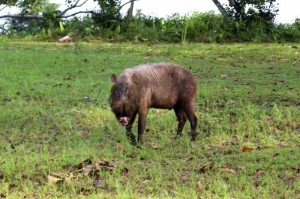 The (usually) Well-Marked Trails
The (usually) Well-Marked Trails
A single trail changes dramatically from beginning to end. One moment the trail is woven with thick, solid roots blanketed with fluorescent green moss and bordered by tropical vegetation. Fifteen minutes later, the forest thins, the plentiful palm fronds have vanished and the trail turns to white sand. Give it another fifteen minutes, and the trail opens onto a wide flat rock surface with low vegetation and a view to the sea. Trails cross over small streams and flowing rivers and many trails lead to beaches. 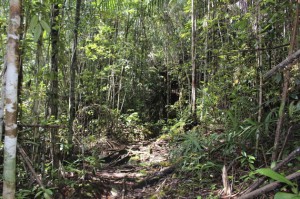
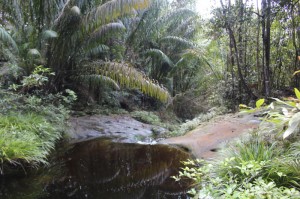
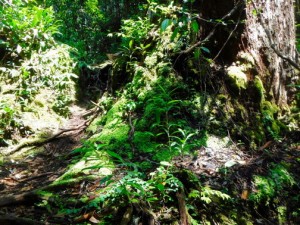
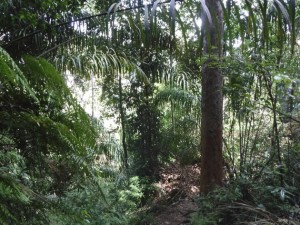
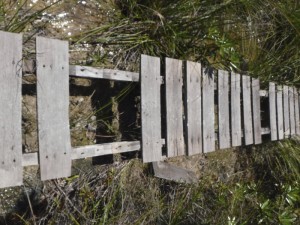
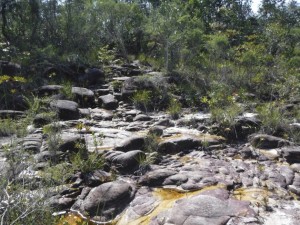
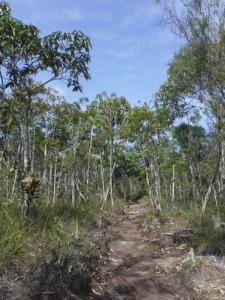
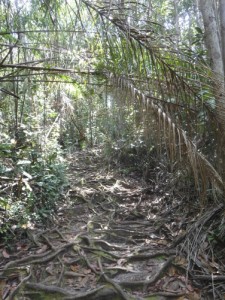
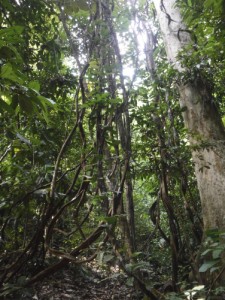
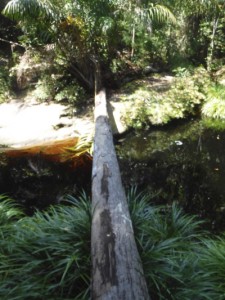
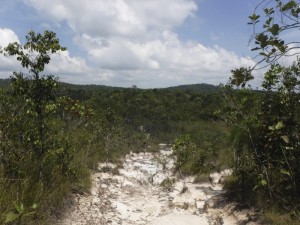
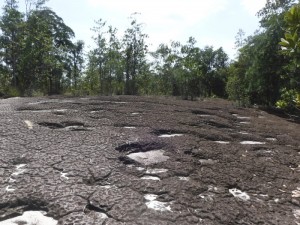 One trail leads to mangroves and another trail leads straight up to a look-out point with a view of the tree tops and the ocean. The view from the lookout point highlights the countless species of trees, as a sea of so many different shades of green with varying texture and shape spread out below.
One trail leads to mangroves and another trail leads straight up to a look-out point with a view of the tree tops and the ocean. The view from the lookout point highlights the countless species of trees, as a sea of so many different shades of green with varying texture and shape spread out below. 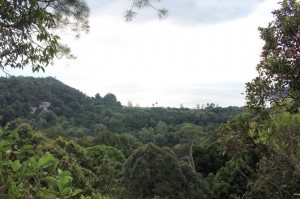 Due to the intense heat, I took a dip in the murky freshwater/saltwater mix at the beaches twice, only getting bit by something once.
Due to the intense heat, I took a dip in the murky freshwater/saltwater mix at the beaches twice, only getting bit by something once. 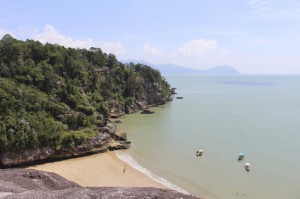
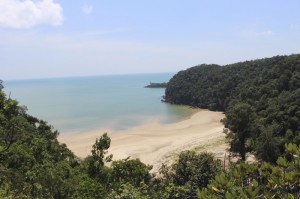
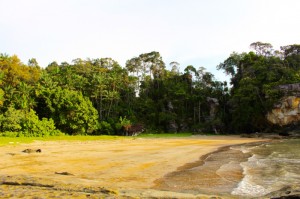 For those who enjoy hiking to music, it would not be necessary in Bako. Rarely a moment of silence, the secadas, birds, frogs, water trickling through streams, blissful wind blowing through the trees and the occasional large but unseen animal thrashing through forest all provide the soundtrack. At one point I heard a chainsaw cutting a tree not too far away and was surprised because Bako is a national park. The sound stopped after a short while and then I heard it again, no more than a few feet away and was shocked to realize it must be an animal, envisioning some sort of super-woodpecker. A park ranger later informed me that it was a secada.
For those who enjoy hiking to music, it would not be necessary in Bako. Rarely a moment of silence, the secadas, birds, frogs, water trickling through streams, blissful wind blowing through the trees and the occasional large but unseen animal thrashing through forest all provide the soundtrack. At one point I heard a chainsaw cutting a tree not too far away and was surprised because Bako is a national park. The sound stopped after a short while and then I heard it again, no more than a few feet away and was shocked to realize it must be an animal, envisioning some sort of super-woodpecker. A park ranger later informed me that it was a secada.
Spiders seem to rest in places where a hiker might place her hand for support while climbing a steep path. Thick tree branches and trunks covered in spikes also sit at the perfect handrail level. The smart hiker quickly learns to look before touching. 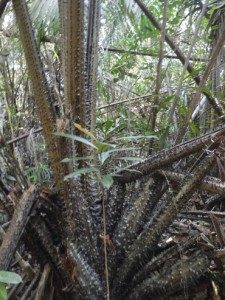
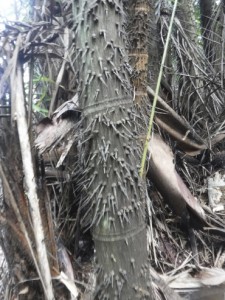 Pitcher plants, a carnivorous plant, grow along the trails. Pitcher plants have deep cavities filled with a sweet nectar that attract insects. Once the insect is lured inside, it cannot climb out of the goo up the slippery walls and the plant actually closes, trapping the insect inside. Then, chemicals in the nectar turn the insects into mush and the plant absorbs the nutrients.
Pitcher plants, a carnivorous plant, grow along the trails. Pitcher plants have deep cavities filled with a sweet nectar that attract insects. Once the insect is lured inside, it cannot climb out of the goo up the slippery walls and the plant actually closes, trapping the insect inside. Then, chemicals in the nectar turn the insects into mush and the plant absorbs the nutrients. 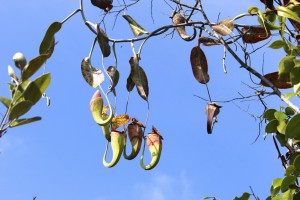 After hiking all day, Bako’s overnight visitors are rewarded with spectacular sunsets.
After hiking all day, Bako’s overnight visitors are rewarded with spectacular sunsets. 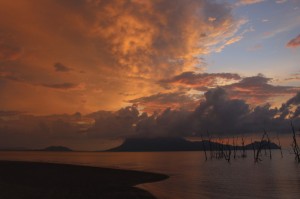
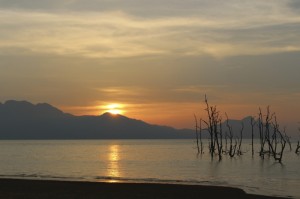 All meals are served in the canteen.
All meals are served in the canteen. 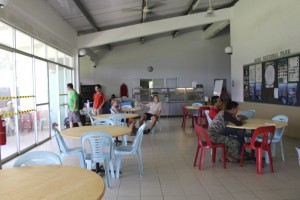
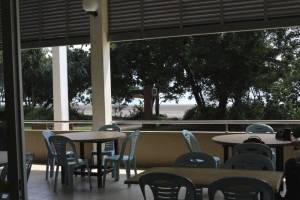 Accommodation in the park is limited and can be difficult to book. This is understandable given everything the park has to offer.
Accommodation in the park is limited and can be difficult to book. This is understandable given everything the park has to offer. 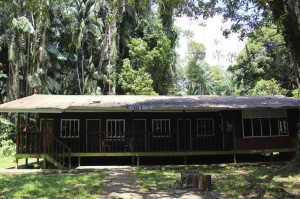
Useful Information
Getting there
From Kuching, take a taxi or Petra Jaya Bus No. 6 to Kampung Bako (Bako Village). The journey takes approximately 45 minutes. Boats can be chartered at the National Parks Boat Ticketing Counter next to the jetty for the 30-minute boat ride to the Park HQ whilst registering your arrival at the Park Arrival Booth. Check with the National Parks Booking Office in Kuching for the latest boat fares. Local tour operators also organise guided trips to Bako.
Accommodation
Park accommodation consists of 3-bedroom Chalets, 2-bedroom Lodges, 4-bedroom Hostels and a camping ground. Barbecue pits are provided for visitors to prepare their own meals. Please contact the National Parks Booking Office for the latest room rates and to make reservations.
Contacts
Bako National Park, Park HQ
Tel : (+60)82-478012
National Parks Booking Office
C/O Visitors Information Centre,
Address : Jalan Tun Abang Haji Openg, 93000 Kuching Sarawak.
Tel : (+60)82-248088 Fax: (+60)82-248087
Online booking : http://ebooking.com.my
Sarawak Forestry
Tel : (+60)82-610088 Fax : (+60)82-610099 Toll free line : 1 800 88 2526
Email : info@sarawakforestry.com URL : www.sarawakforestry.com/htm/snp-np-bako.html
Kuching Visitors’ Information Centre
Located in the Old Courthouse Complex
Tel : (+60)82-410944/410942 Fax : (+60)82-256301
Email : vic-kuching@sarawaktourism.com
Sarawak Tourism Board
Address : 6th & 7th Floor, Bangunan Yayasan Sarawak, Jalan Masjid, 93400 Kuching, Sarawak, Malaysia.
Tel : (+60)82-423600 Fax : (+60)82-416700
Email : stb@sarawaktourism.com URL : www.sarawaktourism.com
style=”display:block”
data-ad-client=”ca-pub-1631392664199333″
data-ad-slot=”5998249538″
data-ad-format=”autorelaxed”>

